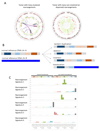Mutational Signatures in Breast Cancer: The Problem at the DNA Level
- PMID: 28572256
- PMCID: PMC5458139
- DOI: 10.1158/1078-0432.CCR-16-2810
Mutational Signatures in Breast Cancer: The Problem at the DNA Level
Abstract
A breast cancer genome is a record of the historic mutagenic activity that has occurred throughout the development of the tumor. Indeed, every mutation may be informative. Although driver mutations were the main focus of cancer research for a long time, passenger mutational signatures, the imprints of DNA damage and DNA repair processes that have been operative during tumorigenesis, are also biologically illuminating. This review is a chronicle of how the concept of mutational signatures arose and brings the reader up-to-date on this field, particularly in breast cancer. Mutational signatures have now been advanced to include mutational processes that involve rearrangements, and novel cancer biological insights have been gained through studying these in great detail. Furthermore, there are efforts to take this field into the clinical sphere. If validated, mutational signatures could thus form an additional weapon in the arsenal of cancer precision diagnostics and therapeutic stratification in the modern war against cancer. Clin Cancer Res; 23(11); 2617-29. ©2017 AACRSee all articles in this CCR Focus section, "Breast Cancer Research: From Base Pairs to Populations."
©2017 American Association for Cancer Research.
Figures





References
-
- Ching HC, Naidu R, Seong MK, Har YC, Taib NA. Integrated analysis of copy number and loss of heterozygosity in primary breast carcinomas using high-density SNP array. Int J Oncol. 2011;39(3):621–33. - PubMed
-
- Fang M, Toher J, Morgan M, Davison J, Tannenbaum S, Claffey K. Genomic differences between estrogen receptor (ER)-positive and ER-negative human breast carcinoma identified by single nucleotide polymorphism array comparative genome hybridization analysis. Cancer. 2011;117(10):2024–34. - PMC - PubMed
Publication types
MeSH terms
Grants and funding
LinkOut - more resources
Full Text Sources
Other Literature Sources
Medical

